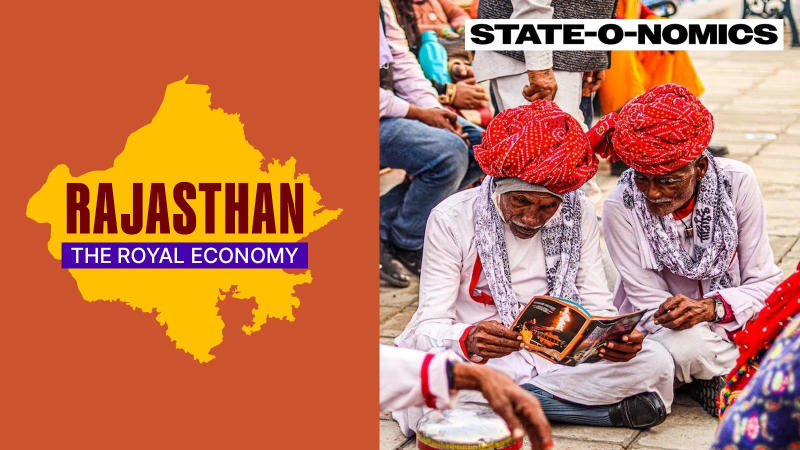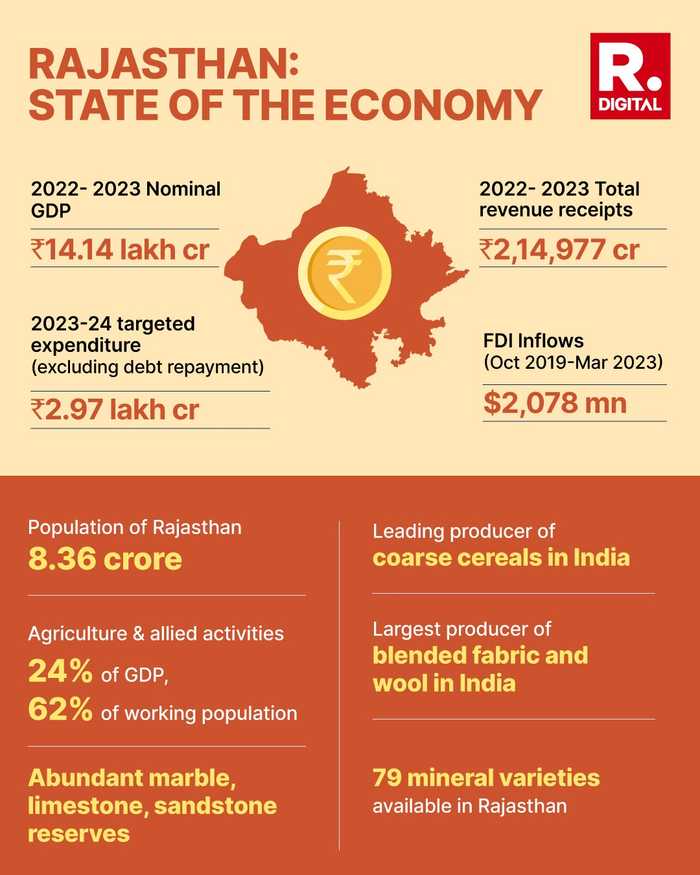Published 14:45 IST, November 6th 2023
State-O-Nomics | Rajasthan’s economy is a fine balance between traditional and modern sectors
Foreign direct investment (FDI) inflows in the state stood at $2,078 million between October 2019-March 2023, according to DPIIT.

Advertisement
Rajasthan, a northern state of India, is all set for its 2023 Legislative Assembly election scheduled for November 25, 2023, to elect all 200 members of the state's Legislative Assembly.

In a recent announcement, Chief Minister Ashok Gehlot highlighted the state's strong economic growth, with a growth rate of 11.04 per cent, despite facing setbacks during the COVID-19 pandemic. He credited the economic management of the state government for this success, noting that Rajasthan's Gross Domestic Product (GSDP) has surged by Rs 6 lakh crore over the past four years.
Current economic status
As per the advance estimates, the nominal GSDP for All India at Current Prices for the year 2022-23 is likely to attain a level of Rs 273.08 lakh crore, showing a growth of 15.4 per cent. In the same year, Rajasthan's GSDP is estimated to contribute 5.18 per cent to the nation's GDP.
Furthermore, foreign direct investment (FDI) inflows in the state stood at $2,078 million between October 2019-March 2023, according to the Department for Promotion of Industry and Internal Trade (DPIIT). These FDI inflows underline the state's growing appeal to international investors and businesses.
Key catalysts of Rajasthan's economic growth
Agricultural sector: In 2021-22, the agricultural and allied sectors contributed 30.23 per cent to Rajasthan's Gross State Value Added (GSVA). The sector displayed a growth rate of 4.78 per cent in 2021-22 compared to the previous year. Rajasthan, however, remains the leading producer of coarse cereals, coriander, pulses, oilseeds, cumin, and garlic.
Services sector: Rajasthan's diverse attractions, including its rich cultural heritage, historical sites, natural landscapes, and the hospitality industry, have boosted the services sector. Tourism has led to an increase in job opportunities in this industry. Additionally, the state's IT sector is expanding, with IT parks established in cities such as Jaipur, Jodhpur, Udaipur, and Kota. Notably, tourism is one of the key sectors in the state. In 2022, 219.88 million domestic tourists and 0.39 million foreign tourists visited Rajasthan. Furthermore, the Rajasthan cabinet had approved the Rajasthan Film Tourism Promotion Policy 2022 with the objective of promoting film production activities in the state.
Industry and Manufacturing sector: This sector comprises various industries, including cement, mining and minerals, auto and auto components, textiles, agro-based industries, ceramics, salt production, and small-scale industry clusters. Rajasthan's vast limestone reserves make it a significant cement producer. The state is India's second-largest mineral producer, especially in lead and zinc. It also has a growing auto component manufacturing industry.
Renewable Energy: Rajasthan is a notable producer of renewable energy sources, including solar, wind, biomass, and solar rooftop installations. As of May 2023, Rajasthan had a total installed power generation capacity of 39,118.86 MW, of which 3,937.36 MW was under the central utilities 8,890.35 MW under state utilities and 26,291.15 MW under private sector. Of the total installed power generation capacity, 14,102.19 MW was contributed by thermal, 1,941.93 MW by hydro and 22,518.00 MW by renewable energy, according to the Indian Brand Equity Foundation.
Rajasthan's economy has evolved over the years, with a blend of traditional and modern sectors driving its growth. The state government remains committed to infrastructure development, promoting industrial growth, and harnessing its cultural heritage and tourism potential for economic development. However, challenges such as water scarcity and poverty in certain regions continue to be areas of focus for sustained economic growth and development in Rajasthan.
14:45 IST, November 6th 2023




